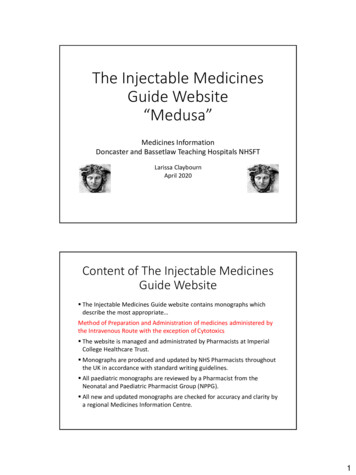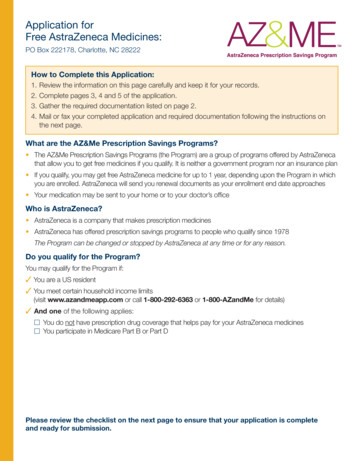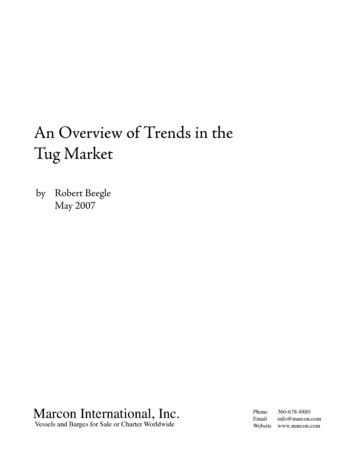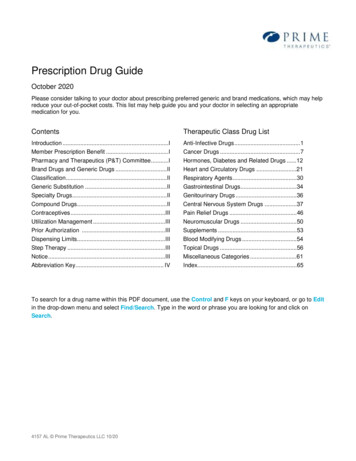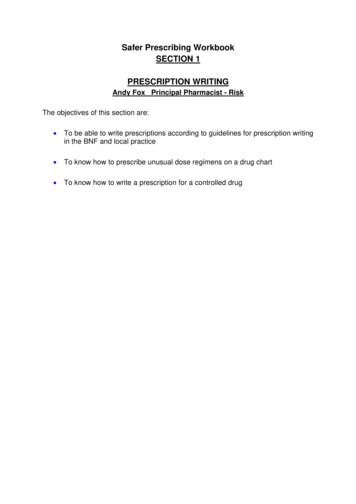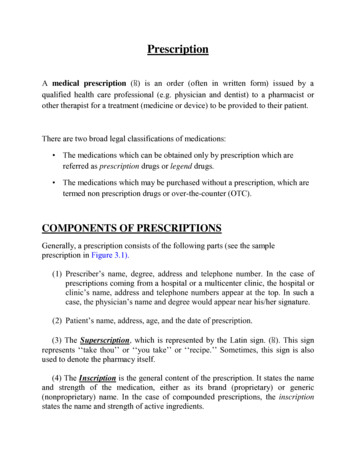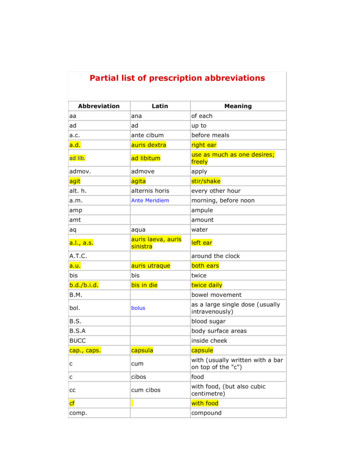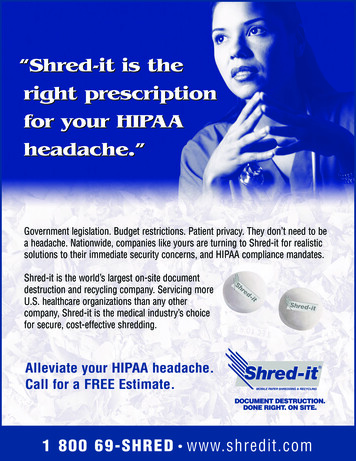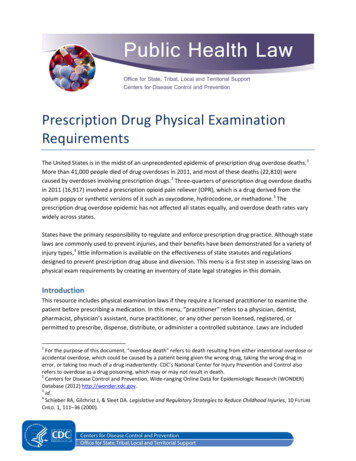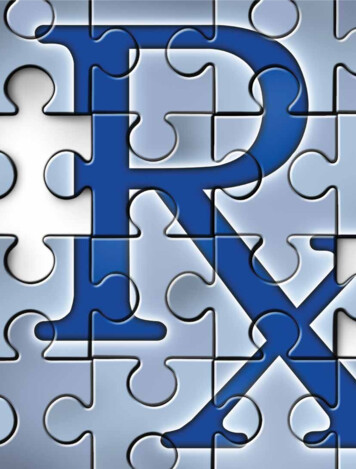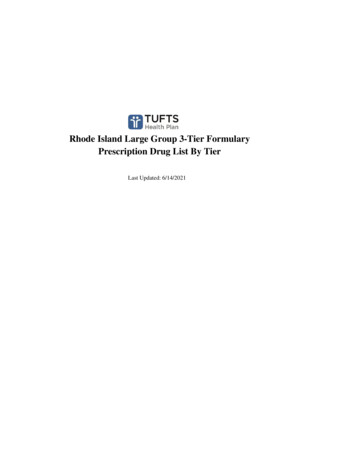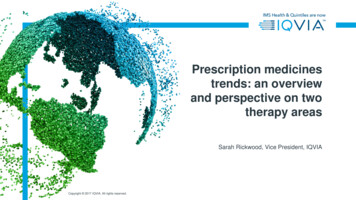
Transcription
Prescription medicinestrends: an overviewand perspective on twotherapy areasSarah Rickwood, Vice President, IQVIACopyright 2017 IQVIA. All rights reserved.
We will discuss four issuesGlobal prescription medicine volume growth is deceleratingGlobal prescription medicine value spend has also deceleratedAntibiotics are a therapy class challenged by unmet need but innovationdeficitOrphan drugs for rare diseases see high levels of innovation but budgetchallenge1
A word on value measurementsWhere IQVIA data is expressed at value level in this presentation, this is at ex-Manufacturer level, list priceList price List price is a price level for a medicine either publically available or estimated from public sources, from which nonpublically available discounts or rebates may be made, meaning the actual price the manufacturer realises is in factlower. These non publically available rebates/discounts can be substantial- it is now estimated that the average discount inthe US to private insurers is now 41%, up from 28% in 2012*. These rebates and discounts are also almost entirely non transparent, with confidentiality agreements between buyerand supplier frequent.Ex-manufacturer level This means that margins added by wholesalers, retail pharmacies and any other elements of the distribution chain tothe patient are not captured, nor are any other tariffs of taxes. In many countries these are regulated margins. In somecountries they are not. A certain level of mark-up added by distributors is the necessary cost of delivering medicines to patients safely,securely, and reliably by commercial enterprise. However, in some countries where distribution margins areunregulated and/or distribution is inefficient and involves many actors, mark-ups can substantially increase the costof medicines to the patient.* Wells Fargo report, January 20182
Global prescription medicines volume growth slows;Pharmerging markets have seen the strongest slowdownCAGR 2007-2012CAGR 2012-2017CAGR 2017-20225,000TrnStandard Units,Total world, audited and 072012Pharmerging20172022OthersSource: IQVIA Institute, Oct 2017. Pharmerging is a group of IQVIA defined pharmerging markets characterized by less than 30k GDP/capita and greater than 1bn absolute prescription medicines market growth potential between 2014 and 2019. The markets are: China Brazil India Russia MexicoTurkey Poland Saudi Arabia Indonesia Egypt Philippines Pakistan Vietnam Bangladesh Argentina Algeria Colombia South Africa Chile Nigeria Kazakhstan
Pharmaceutical volume per capita varies widely in pharmergingcountries, as does the potential for growthPharma SU volume per capita index forPharmerging countries for 2017 and 2022RUSSIAN LOMBIASOUTH AFRICASAUDI iginal brandedproducts (protected orunprotected) represent 715% of pharmergingmedicine volumes and19-34% of list price exmanufacturer value; mostvolume/value is nonoriginal-200204060Index of SU Per Capita to Developed Markets Average in 2017high income markets’Volume in SU per capita 1002017 1,4572022 1,48780100SU Per Capita Incremental to 2022120140Source: IQVIA Institute, Oct 2017. Pharmerging is a group of IQVIA defined pharmerging markets characterized by less than 30k GDP/capita and greater than 1bn absolute prescription medicines market growth potential between 2014 and 2019. The markets are: China Brazil India Russia Mexico Turkey PolandSaudi Arabia Indonesia Egypt Philippines Pakistan Vietnam Bangladesh Argentina Algeria Colombia South Africa Chile Nigeria Kazakhstan Note: High Income markets are known for wider adoption of newer therapies whose clinical importance is often understatedin Standard Units. Pharmerging markets are known for historically less well resourced health systems and often use oral and older medicines to a greater extent. The index may overstate the gains being made by Pharmerging markets relative to more clinical orhealth outcomes based measures. Although the South African market has been strongly affected by weak economic growth, changes in data coverage may also affect this market’s recent history.
Global Market Spending, based on list price, to grow 3-6% invalue in the next five yearsGlobal pharma spending and growth2007 -20221,400Resurgence of spend oninnovative medicines inhigh income markets,list price growth in US,peak Hepatitis C spendSpending US Bn1,2001,00080010%8%6%600400200Moderatinggrowth ofpharmergingmedicine spendHeavy small moleculegenericisationEconomic austerity inUS/Europe/Japan2016 IQVIA estimate ofdifference between listprice and net sales forthe US 33%, or 148bn12%04%2%Growth Constant US 1,6002016 IQVIA estimate ofdifference between listand net for rest of world 18% or 96bnAn estimate of thedifference between listprice and net value istherefore 25% globally,but with substantialcaveats.0%2007 2008 2009 2010 2011 2012 2013 2014 2015 2016 2017 2018 2019 2020 2021 2022SpendingSource: IQVIA Market Prognosis, Sept 2017; IQVIA Institute, Oct 2017- Outlook for Global Medicines through 2021Growth5
Below this list price picture, rebates and discounts have grownstrongly, although recently moderating in USRest of World DataGlobal and US difference between gross (MIDAS list price) and estimated netpharmaceutical market value (2009-16)Rest of WorldUS35%30%25% Calculation based on the ratio of MIDASsales and company reported Net sales on aproduct by product basis Starting universe of 297 productsrepresenting 11% of MIDAS sales (2016)and 9% of RoW sales 2016 RoW value (18% discount)constructed from 112 data points20%Caveats 15%10% 5%0%20092010201120122013201420152016Notes: US calculation from IQVIA Institute; RoW calculation using a universe of 297 products representing 21% of MIDAS sales in 2016; Anomalous products excludedSource: IQVIA Thought Leadership Analysis, IQVIA Analytics Link, IQVIA Institute; IQVIA MIDAS MAT Q2 2017Crude calculation – no distinction possiblebetween high and low income economiesoutside US, but this is likely skewed tohigh income countriesStarting universe of products are companyreported – so typically new products orthose with significant sales for a publicallyquoted company. No Genericscontribution.6
Inefficient use of existing medicines generates avoidable costs:non compliance is the biggest cost, antibiotics misuse third The inefficient use of existing medications, whether on or offpatent, incurs substantial, avoidable costs for healthcaresystems Non-adherence to prescribed medicines regimens is the singleEstimated avoidable costs (2012) bn USDNon-adherence57%269Delayed evidence-basedtreatment practise13% 62greatest avoidable cost- although a perennially challengingissue, even small improvements would result in substantialsavings Antibiotic misuse (antibiotic use for non bacterial infections)was the third largest source of waste, and, although it hasseen recent substantial effort to address, cost 2012healthcare systems 54bn in avoidable spendSource: IQVIA European Thought Leadership; IQVIA Institute 2012 “Responsible use of Medicine”Antibiotic misuse11% 54Medication errors9% 42Suboptimal generic use6% 30Mismanaged polypharmacyin the elderlyTotal avoidable costs4% 18100%4757
Antibiotics and orphan drugs: opposite ends of the innovationspectrumHow do medicines challenge healthcare systems? What is the impact of regulation and commercial activity?AntibioticsMarket lation/policyOrphan drugs High prevalence conditions, acute Established treatment paradigm High share of generic standard of care Extremely low individual prevalence conditions(although there are many of them) chronic Emerging/radically changing treatment paradigm No or low share of generics Focus on generics for the broadest population Focus on reducing unit cost (where payers are institutions orgovernments) Action to reduce mis-use (but still a major problem and source ofunnecessary medicine spend) New products may see restricted use as “antibiotic of last resort”- salesare low Cost per patient is high and a growing concern in high incomemarkets Individual products can have low sales, but collectively treatments forrare diseases are a growing element of high income market medicinespend Orphan drugs increasingly the subject of strict price negotiation andhealth technology assessment Commercial launch of new antibiotics washistorically frequent but is now rare Commercial launch of new orphan drug treatments was historicallyrare but is now frequent and increasing However, only an estimated 5% of rare diseases currently have apharmacotherapy Significant global legislation and action to manage antibiotic use andcontain resistance GAIN provision as part of 2012 FDA safety and innovation act (US) aimsto improve commercial attractiveness with additional 5 years exclusivity EU Innovative Medicines Initiative ND4BB program and setting up ofJPIAMR since 1999 1983 Orphan drug act (US) , 2000 Regulation (EC) 141/2000 (EU)both have given substantial encouragement to companiesdeveloping drugs for rare diseases Japan, Singapore and Australia have also enacted legislation whichencourages development of orphan drugs8
Usage of systemic antibiotics declines in high income markets;from 2016 we see the same trend for pharmerging marketsSystemic antibiotics* Sales in Volume (Bn SU)Standard Unit volume for Systemicantibiotics falls in both pharmergingmarkets (low/middle income) andhigh income markets10090-2.7% 1.7%80Global7060-3.4% 1420152016Source: IQVIA European Thought Leadership; IMS MIDAS Q3/2017; *only systemic antibiotics (ATC J1)2017Volume decreases 2015-17 inChina, Brazil, Turkey, South Africa,Thailand, Philippines, Saudi Arabia,Poland, Vietnam and Chile (10/20pharmerging markets)Volume rises 2015-17 inKazhakstan, Algeria, Egypt,Pakistan, Russia, India,Bangladesh, Argentina, Colombia,Mexico9
Global New Active Substance launch has seen very little activityfrom systemic antibioticsNAS launches 2010 - 201760# Antibiotic NASs350304030202011201211020100201020132014Note: 2017 NAS data is provisional and is subject toc change ; NAS New Active Substance; Antibiotics include the following ATC3s J1A,B,C,D,E,F,G,H,K,L,M,P,X,J3A,J8Source: IQVIA MIDAS NAS analysis Q3 201720152016201710
In contrast, orphan drug approvals in Europe have risensubstantially since 2000 legislationOrphan drugs in Europe with European MarketAuthorisation by approval year (2008-16) – 135 in totalwere approved between 2001 and 2016202018 146 medicines were reviewed bythe EMA for orphan designationsince 2001-2016. As of 2016:14151110101076455 0200820092010201120122013Source: European Medicines Agency October 2017; *to Oct 2017 only201420152016 90 are approved Orphans 45 have been withdrawn 11 were refused designation91% (82) of approved Orphandrugs in 2016 (90) have sales inEurope in MIDAS2017*11
Growth of orphan drug sales value decelerates in Europe, shareof total pharmaceutical list price spend is 3.5%Orphan drug share of total sales of pharmaceutical use in Europe has increased from 1.5% in 2007 to 3.5% In2016Growth of drug sales (LC 1120122013201420152016-20%-30%Orphans growth rateShare of DrugSales ( )1.5%Source: IQVIA MIDAS MAT Dec 20161.9%2.2%2.7%2.2%Non Orphans growth rate2.3%2.6%3.0%3.3%Note: Products are classified as “Orphan” in any given year,but after this year may have been withdrawn, and before thisyear may have been “non-orphan”3.5%12
Concluding points There is currently both volume and value deceleration in spend on Rx medicines globally Many pharmerging markets (where majority of volume and value is off patent) are substantiallybehind the high income markets in terms of use per head of modern medicines, and currentgrowth rates will not close that gap Avoidable costs to healthcare systems of mis-use of prescription medicines equated to 49% oftotal list price Rx market value in 2012, with compliance the leading cost and antiobiotic mis-usethird Orphan drugs see growth of innovation with enabling legislation but costs challenge high incomemarkets Antibiotics see innovation dearth and yet to see impact of policy on new drug approvals13
IQVIA’s definition of Pharmerging Markets: middle-low income countriesthat have significant potential for list price, ex-manufacturer market ssiaPolandAlgeriaSaudi ArabiaColombiaIndonesiaSouth an21 countriesChinaPharmerging DefinitionGDP per capita less than 30,000 1Bn US or LCUS in absolute5yr growth (2014-2019)VietnamTierdefinitionSource: IQVIA Market PrognosisTier 1Tier 2Tier 3 100Bn US sales in 2014 15Bn US salesin 2014 1Bn US or LCUS in absolute 5yrgrowth(2014-2019)
Global and US difference between gross (MIDAS list price) and estimated net pharmaceutical market value (2009-16) Rest of World Data Calculation based on the ratio of MIDAS sales and company reported Net sales on a product by product basis Starting universe of 297 products representing 11% of MIDAS sales (2016) and 9% of RoW salesFile Size: 806KBPage Count: 15
